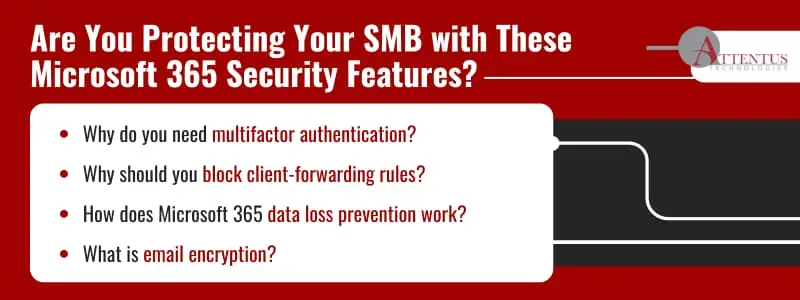From multi-factor authentication to email encryption, here are four Microsoft 365 security tools you shouldn’t skimp on.

Have you implemented all the necessary Microsoft 365 security features to protect your small or medium-sized business (SMB) against threats associated with today’s ever-expanding technology landscape?
Organizations now cite phishing, supply chain attacks, and credential compromise as the top three initial attack vectors, according to IBM’s recently released 2025 Data Breach Report.
Properly configuring your Microsoft 365 security can help mitigate these risks and make your organization harder to infiltrate.
Here’s how to get started.
#1. Implement Multi-Factor Authentication
Multi-factor authentication (MFA) is the first protective barrier you should apply to your Microsoft 365 tenant. Nearly every data and security breach involves some compromise of an account, be it an admin account, a user account, or even a work email address.
Threat actors send a phishing email to an employee to get them to click on a link to a fake login page and steal their credentials, for example. The attackers then use the compromised account to perform further attacks on others.
This is called “pivoting.”
When you apply MFA, every sign-in attempt requires a second-factor validation based on specific timeouts you’ve set. Simply install the authenticator application on a device, then implement MFA either directly against individual users or through conditional-based logic.
MFA protection ensures that attackers need more information than compromised credentials, giving your security a boost.
99.9% of automated account compromise attempts can be thwarted by implementing MFA, according to Microsoft.
#2. Block Client Forwarding Rules
One of the first things attackers do after compromising accounts is create email forwarding rules. This enables them to exfiltrate data out of your organization to external recipients.
So how can you protect your SMB? Block the creation of client forwarding rules to ensure your content doesn’t leave your company.
Here are the available Microsoft 365 security options:
- Disable “allow remote forwarding” or “automatic forwarding” for remote domains on Exchange Online.
- Use role-based access control (RBAC) to limit the creation of and delivery of forwarding.
- Implement a transport rule to prevent emails from being auto-forwarded. You could create a rule that says a message type of “auto-forward” should be rejected if a sender is located in the organization and the recipient is outside.
#3. Configure Data Loss Prevention
Can you prevent people within your organization from sharing valuable, sensitive, or even regulated data? Absolutely. It’s possible through a Microsoft 365 feature called Data Loss Prevention (DLP).
DLP allows you to create specific data policies to avoid leakage. It’s intelligent enough to determine when someone is trying to share credit card information, for example, then block such an action and alert you via email.
Have you properly configured DLP in Microsoft 365? Learn what Microsoft recommends here.
#4. Use Email Encryption
How secure are emails, actually?
Writing an email is like sending a letter. You write it, wrap it in an envelope, and put it in the mail box. But you’re relying on people to deliver that letter to the intended recipient and hoping nobody reads it along the way.
Encryption is the only way to guarantee that bad actors don’t hijack the contents of your email. It scrambles the contents upon send, and they get unscrambled at the other end once opened by the legitimate recipient.
So, before you send the next email, make sure it’s encrypted.
Bonus Features to Implement
Here are other security improvements to consider:
-
Safe Attachments
Ransomware is one of the top tools cybercriminals use in attacks. They infect your computer systems by sending your team malicious attachments that look enticing. You click on the attachment, and you’ve got ransomware. Microsoft 365 Safe Attachments scans files in a virtual environment and blocks the malicious ones before they reach your inbox. You never have to worry about operations coming to a halt because your data or systems are being held for ransom.
-
Compliance Policies
How secure are the devices accessing your Microsoft 365 data? The compliance policy feature allows you to configure policies so every computer or laptop accessing your Microsoft 365 data has antivirus software installed, a hard drive encrypted with BitLocker, and possibly even a secure PIN for login.
Ready to elevate your Microsoft 365 security posture?
Get Expert Help Maximizing Microsoft 365 Security
Staying ahead of the curve is non-negotiable as attacks become more sophisticated and leave more damaging business aftermaths. A good place to start is by maximizing your security on the Microsoft platform.
Need help configuring your Microsoft 365 security? Attentus Technologies is here to help. One of our core values is to “be the answer” to our clients’ most pressing technology pain points.
We can simplify the process of securing your assets on the Microsoft 365 platform, so you can focus on your core business.
Schedule a discovery call today to learn how proactive I.T. is the answer to your security concerns.
